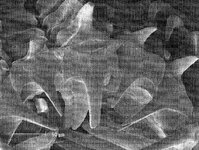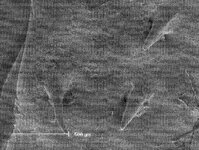- Joined
- Nov 19, 2002
- Messages
- 4,674
Ed: Feb 2008. I just thought that I'd resurrect this thread on the offchance someone out there wanted to undertake a comparative study of these structures as part of a Masters degree. I've left all other thread content as it was/as posted from day 1. Some aspects of this research have been covered in various papers since, and some shortly will be, but the bulk of it, a large-scale comparative study, never has been undertaken. Any takers?.
I'm taking a huge gamble in placing these images online. An ever-so-slighty exciting opportunity exists for someone to research comparative morphology of palatine teeth in cephalopods, both octopus and squid, linking this to diet, and describing ontogenetic shifts in their structure (in accordance with changes in diet throughout a species life cycle).
No project of this nature has ever been undertaken before; it is a world first.
I've attached a few 'modified' images here (some duplicated in Fossils & History, in a thread titled 'Challenge') to show you what you can expect to see with SEM microscopy (similar images, although not as detailed, can be obtained with light microscopy).
I am certain the shape and distribution of these radular-like structures is of both systematic and ecological significance. The project would involve describing these structures across all cephalopod taxa that we have here (very diverse collections), and examination of squid stomach contents, to ascertain any link between their density, form and distribution and the squid's diet.
Exciting stuff!! Suitable for Masters (if you have some experience) or PhD.
Just a selection of pics follow.
The first image is of the buccal mass, with beaks and beak musculature removed (of the arrow squid, Nototodarus). The radula is pretty obvious, below the salivary papilla. Running down, either side of the buccal mass are the palatine palps, upon the inner face of which you will see dagger-like projections (the palatine teeth). The other two images are close ups of these palatine and true radular teeth in two taxa (a rather large, unknown species of squid; and Nototodarus). They also occur in some species of 'octopus', Vampyroteuthis and most all other octopus and squid taxa (in fact their absence is extremely interesting, and must reflect some specialised diet).
An additional radular-like tooth is sometimes found in the salivary papilla of hole-drilling octopus species; there's so much that we haven't looked at in octopus and squid systematics; the world is your oyster!
I'm taking a huge gamble in placing these images online. An ever-so-slighty exciting opportunity exists for someone to research comparative morphology of palatine teeth in cephalopods, both octopus and squid, linking this to diet, and describing ontogenetic shifts in their structure (in accordance with changes in diet throughout a species life cycle).
No project of this nature has ever been undertaken before; it is a world first.
I've attached a few 'modified' images here (some duplicated in Fossils & History, in a thread titled 'Challenge') to show you what you can expect to see with SEM microscopy (similar images, although not as detailed, can be obtained with light microscopy).
I am certain the shape and distribution of these radular-like structures is of both systematic and ecological significance. The project would involve describing these structures across all cephalopod taxa that we have here (very diverse collections), and examination of squid stomach contents, to ascertain any link between their density, form and distribution and the squid's diet.
Exciting stuff!! Suitable for Masters (if you have some experience) or PhD.
Just a selection of pics follow.
The first image is of the buccal mass, with beaks and beak musculature removed (of the arrow squid, Nototodarus). The radula is pretty obvious, below the salivary papilla. Running down, either side of the buccal mass are the palatine palps, upon the inner face of which you will see dagger-like projections (the palatine teeth). The other two images are close ups of these palatine and true radular teeth in two taxa (a rather large, unknown species of squid; and Nototodarus). They also occur in some species of 'octopus', Vampyroteuthis and most all other octopus and squid taxa (in fact their absence is extremely interesting, and must reflect some specialised diet).
An additional radular-like tooth is sometimes found in the salivary papilla of hole-drilling octopus species; there's so much that we haven't looked at in octopus and squid systematics; the world is your oyster!




 Too cool. 8)
Too cool. 8) 
